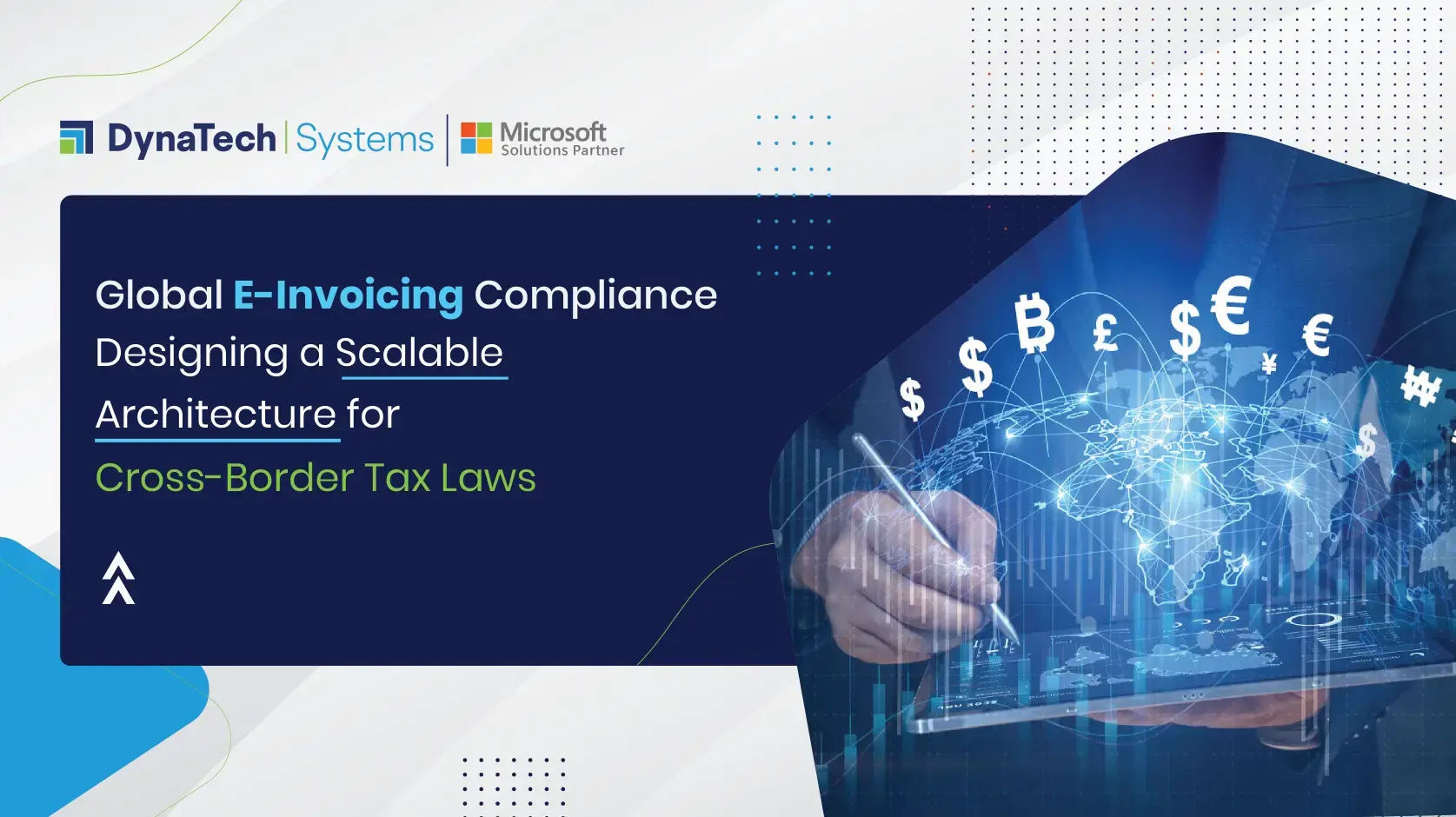It starts with one country. Then three. Then ten. Before you know it, you're managing e-invoicing rules across a dozen jurisdictions—each with its own tax logic, format, approval process, and submission method. This isn't invoicing anymore. It's engineering for global tax compliance.
Governments are pushing hard on digital tax compliance, and there's no consistency. One market demands real-time clearance. Another asks for periodic reporting. APIs change overnight. Local laws shift without warning. If you're running disconnected tools or relying on manual workarounds, it's only a matter of time before something fails—and the penalties won't wait.
You don't fix this with patches. You fix it with architecture. A cloud-based e-invoicing solution that scales, understands multi-country e-invoicing compliance, and talks directly to your ERP—automating tax logic at the source and keeping every invoice in line with local mandates. If your business runs on Microsoft Dynamics 365, you're already halfway there. What is the rest? That's what we cover in the blog.
Global Tax Compliance Isn't Optional. It Never Really Was
It's no longer about just sending an invoice and calling it a day. Governments are building systems that want your data in real time, in their format, with their validations, and through their channels. Not later. Not when you're ready. Now.
And if you get it wrong? It doesn't just sit in an error queue. You deal with delayed payments. Blocked shipments. Fines. Or worse, losing trust with clients because you couldn't get an invoice through.
The bigger issue? Every country speaks a different language when it comes to e-invoicing. Different rules. Different formats. Different logic. You can't keep duct-taping local fixes and expect it to scale. If you're serious about multi-country e-invoicing compliance, you need one system that sees the whole map, moves with the laws, and doesn't fall apart every time something changes.
Core Components of a Scalable E-Invoicing Architecture
To support a truly global invoicing ecosystem, companies must build a system that isn't just compliant but resilient, automated, and future-ready. Here's what a robust e-invoicing framework should include:
Cloud-Based E-Invoicing Solutions
Cloud-first architectures ensure that your invoicing system is scalable, secure, and available for global access. They enable real-time updates for tax schema changes and deliver rapid deployment across regions.
ERP-Driven Financial Automation
Integration with ERP platforms like Microsoft Dynamics 365 ensures that invoicing remains a seamless part of the end-to-end order-to-cash cycle. Learn more about how ERP-integrated e-invoicing compliance reduces manual errors and boosts automation. ERP-driven financial automation eliminates manual data entry, reduces errors, and accelerates invoice processing.
Plug-and-Play API Connectivity
When managing e-invoicing across borders, dealing with different country systems like India's IRP or Italy's SDI can be messy. That's where standardized APIs come in — they act as the bridge between your ERP and local government platforms, enabling seamless two-way data exchange for invoice submission, status updates, validations, and confirmations.
Smarter Compliance Layer
No two countries follow the same rules when it comes to digital invoicing. A strong compliance engine adapts to each region's quirks — whether it's assigning the right tax codes, handling e-signature mandates, or making sure archiving meets local retention laws. Think of it as the local expert working behind the scenes.
Live Insights & Digital Paper Trails
You can't fix what you can't see. With real-time monitoring dashboards, alerts, and audit logs, your team stays one step ahead. Spot issues early, track each invoice through its lifecycle, and ensure nothing slips through the cracks — all while staying compliant with tax authority expectations.
Future-Ready E-Invoicing: How to Build a Scalable Framework from Day One
As enterprises expand across borders, tax compliance quickly shifts from a finance task to a mission-critical function. A modern e-invoicing framework must do more than meet today's requirements—it must scale with tomorrow's complexity.
Instead of patching together region-specific fixes, future-ready organizations are investing in modular, cloud-based e-invoicing solutions that support growth across jurisdictions and business entities.
Here's how to architect a framework built for long-term multi-country e-invoicing compliance:
1. Localization That Works with You, Not Against You
No two countries share the same playbook when it comes to e-invoicing. What's accepted in Mexico might be rejected in Poland. You've got SAF-T in Portugal, FatturaPA in Italy, India's e-invoice registration numbers (IRNs), and then Latin America's real-time clearance requirements that throw in another twist altogether.
Instead of building different systems from scratch each time your business expands to a new geography, modular localization tools can do the heavy lifting. They adapt to:
- Country-specific formats — whether you're dealing with XML schemas, JSON-based definitions, or market-specific PDF templates tailored for local authorities.
- Tax differences — from regionally accepted currencies and tax IDs to how fields like GST, VAT, or withholding tax need to be positioned on the invoice.
- Legal mandates — including verified digital signatures, mandatory QR codes, unique invoice identifiers (UUIDs), and jurisdiction-based compliance stamps or codes.
You keep scaling your business. The system silently keeps you compliant. No rewrites, no duplicated effort, just local accuracy at global scale.
2. Global Master Data Governance
One of the most overlooked challenges in e-invoicing compliance is poor data quality. Disparate systems lead to mismatches in customer/vendor records, tax IDs, and address formatting.
Integrating ERP-driven financial automation and global Master Data Management (MDM) helps you:
- Standardize customer and vendor records across all regions
- Eliminate data redundancy and errors
- Improve invoice acceptance rates by ensuring clean, validated inputs
This makes your entire global tax compliance process smoother and more reliable.
3. Smart Invoice Routing & Pre-Validation
Today's e-invoicing systems need to intelligently determine:
- Where to send an invoice (e.g., India's IRP, Italy's SDI, PEPPOL, etc.)
- How to format it according to local mandates
- Whether it passes schema validation before government submission
Advanced routing engines and pre-validation logic reduce failure rates, boost automation, and ensure e-invoicing compliance from the first attempt.
The Role of Microsoft Dynamics 365 in E-Invoicing Transformation
DynaTech leverages the power of ERP-driven financial automation using Microsoft Dynamics 365 Finance and Operations. With built-in capabilities for global tax reporting, electronic document management, and localization packs, Dynamics 365 becomes the central nervous system for a compliant invoicing strategy.
Paired with our custom solutions like Global E-Invoicing Connector and Tax Compliance Automation Toolkit, DynaTech simplifies global tax compliance for multi-entity enterprises.
Whether it's ensuring tax-compliant invoicing automation in Brazil or enabling cloud-based e-invoicing solutions in Europe, our platform adapts and scales to match your growth.
What's Next: Navigating E-Invoicing Without Getting Caught in the Crossfire
Real-time e-invoicing mandates aren't coming — they're already here. And they're not slowing down. For global businesses, this isn't just another IT upgrade. It's a shift in how you operate, report, and respond — across borders, in real time.
Relying on local, disconnected systems only creates bottlenecks and risks. What you need now is a central e-invoicing backbone — one that aligns with government portals, adjusts quickly to new rules, and frees your teams from chasing compliance checklists.
The outcome is unimaginable:
- Faster payment cycles.
- Fewer audit headaches.
- A system that doesn't break every time the rules change.
Because in this environment, staying compliant is no longer enough — you need to stay ready.
Closing Statement: Architecting Compliance That Commands Confidence
In a world where tax rules shift faster than market trends, e-invoicing isn't just about staying compliant — it's about staying in control. At DynaTech, we don't just plug gaps — we build intelligent, future-ready invoicing ecosystems that speak the language of global regulators and your bottom line.
With deep-rooted expertise in Microsoft Dynamics 365 and a sharp focus on industry-specific compliance mandates, we don't offer one-size-fits-all. We offer precision-fit digital frameworks that flex with every tax rule, every country, and every future pivot.
If you're expanding across borders, or simply tired of chasing compliance fires — it's time to rethink your approach. Let DynaTech be the Microsoft dynamics partner that not only keeps you audit-ready but turns regulatory complexity into strategic clarity.




























